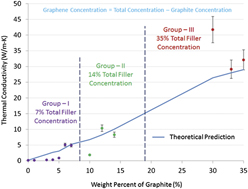Crossref Citations
This article has been cited by the following publications. This list is generated based on data provided by
Crossref.
Renteria, J.
Legedza, S.
Salgado, R.
Balandin, M.P.
Ramirez, S.
Saadah, M.
Kargar, F.
and
Balandin, A.A.
2015.
Magnetically-functionalized self-aligning graphene fillers for high-efficiency thermal management applications.
Materials & Design,
Vol. 88,
Issue. ,
p.
214.
Bigdeli, Masoud Bozorg
and
Fasano, Matteo
2017.
Thermal transmittance in graphene based networks for polymer matrix composites.
International Journal of Thermal Sciences,
Vol. 117,
Issue. ,
p.
98.
Ruminski, Anne M.
Yang, Fan
Cho, Eun Seon
Silber, Joseph
Olivera, Edgar
Johnson, Thomas
Anderssen, Eric C.
Haber, Carl H.
and
Urban, Jeffrey J.
2017.
Geometric analysis of enhanced thermal conductivity in epoxy composites: A comparison of graphite and carbon nanofiber fillers.
physica status solidi (a),
Vol. 214,
Issue. 1,
Singh, Amit K.
Panda, Bishnu P.
Mohanty, Smita
Nayak, Sanjay K.
and
Gupta, Manoj K.
2017.
Study on metal decorated oxidized multiwalled carbon nanotube (MWCNT) - epoxy adhesive for thermal conductivity applications.
Journal of Materials Science: Materials in Electronics,
Vol. 28,
Issue. 12,
p.
8908.
Mu, Mulan
Wan, Chaoying
and
McNally, Tony
2017.
Thermal conductivity of 2D nano-structured graphitic materials and their composites with epoxy resins.
2D Materials,
Vol. 4,
Issue. 4,
p.
042001.
Phiri, Josphat
Gane, Patrick
and
Maloney, Thad C.
2017.
General overview of graphene: Production, properties and application in polymer composites.
Materials Science and Engineering: B,
Vol. 215,
Issue. ,
p.
9.
Nguyen, Nam
Melamed, Eric
Park, Jin Gyu
Zhang, Songlin
Hao, Ayou
and
Liang, Richard
2017.
Direct Printing of Thermal Management Device Using Low‐Cost Composite Ink.
Macromolecular Materials and Engineering,
Vol. 302,
Issue. 10,
Kumar, Rajesh
Nayak, Sagar Kumar
Panda, Bishnu P.
Mohanty, Smita
and
Nayak, Sanjay K.
2018.
Advances in Polymer Sciences and Technology.
p.
83.
Kumar, Rajesh
Nayak, Sagar Kumar
Sahoo, Swarnalata
Panda, Bishnu P.
Mohanty, Smita
and
Nayak, Sanjay K.
2018.
Study on thermal conductive epoxy adhesive based on adopting hexagonal boron nitride/graphite hybrids.
Journal of Materials Science: Materials in Electronics,
Vol. 29,
Issue. 19,
p.
16932.
Malekpour, Hoda
and
Balandin, Alexander A.
2018.
Nanopackaging.
p.
823.
Hussein, Seenaa I.
Abd-Elnaiem, Alaa M.
Asafa, Tesleem B.
and
Jaafar, Harith I.
2018.
Effect of incorporation of conductive fillers on mechanical properties and thermal conductivity of epoxy resin composite.
Applied Physics A,
Vol. 124,
Issue. 7,
Russo, P.
Patti, A.
Petrarca, C.
and
Acierno, S.
2018.
Thermal conductivity and dielectric properties of polypropylene‐based hybrid compounds containing multiwalled carbon nanotubes.
Journal of Applied Polymer Science,
Vol. 135,
Issue. 28,
Siddiqui, MU
and
Arif, Abul Fazal M
2018.
Estimation and optimisation of effective thermal conductivity for polymer matrix composites with hybrid inclusions.
Journal of Composite Materials,
Vol. 52,
Issue. 16,
p.
2139.
Peng, Cheng
and
Feng, Yefeng
2018.
Finely balanced high heat conductivity, peel strength and breakdown voltage in polymer composites with binary hybrid inorganic fillers.
Materials Research Express,
Vol. 5,
Issue. 6,
p.
066409.
Zhang, Yinhang
Park, Mira
and
Park, Soo-Jin
2019.
Implication of thermally conductive nanodiamond-interspersed graphite nanoplatelet hybrids in thermoset composites with superior thermal management capability.
Scientific Reports,
Vol. 9,
Issue. 1,
Xue, Yixuan
Chen, Yang
Li, Zhen
Jiang, Jin-Wu
Zhang, Yingyan
and
Wei, Ning
2019.
Strain engineering for thermal conductivity of diamond nanothread forests.
Journal of Physics D: Applied Physics,
Vol. 52,
Issue. 8,
p.
085301.
Xing, Zhonghao
Sun, Wen
Wang, Lida
Yang, Zhengqing
Wang, Suilin
and
Liu, Guichang
2019.
Size-controlled graphite nanoplatelets: thermal conductivity enhancers for epoxy resin.
Journal of Materials Science,
Vol. 54,
Issue. 13,
p.
10041.
Nayak, Sagar Kumar
Mohanty, Smita
and
Nayak, Sanjay K.
2019.
Silver (Ag) nanoparticle-decorated expanded graphite (EG) epoxy composite: evaluating thermal and electrical properties.
Journal of Materials Science: Materials in Electronics,
Vol. 30,
Issue. 23,
p.
20574.
Phuangngamphan, M.
Okhawilai, M.
Hiziroglu, S.
and
Rimdusit, S.
2019.
Development of highly conductive graphite‐/graphene‐filled polybenzoxazine composites for bipolar plates in fuel cells.
Journal of Applied Polymer Science,
Vol. 136,
Issue. 11,
Kumar, Rajesh
Mohanty, Smita
and
Nayak, Sanjay K.
2019.
Study on epoxy resin-based thermal adhesive filled with hybrid expanded graphite and graphene nanoplatelet.
SN Applied Sciences,
Vol. 1,
Issue. 2,





